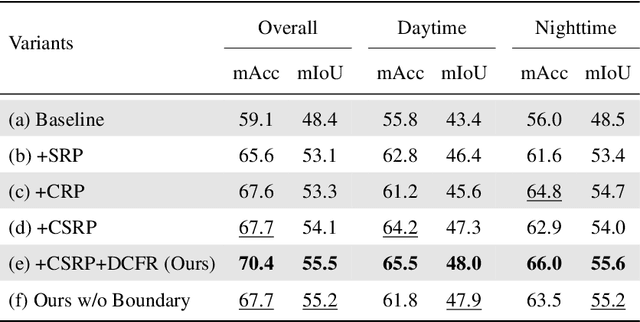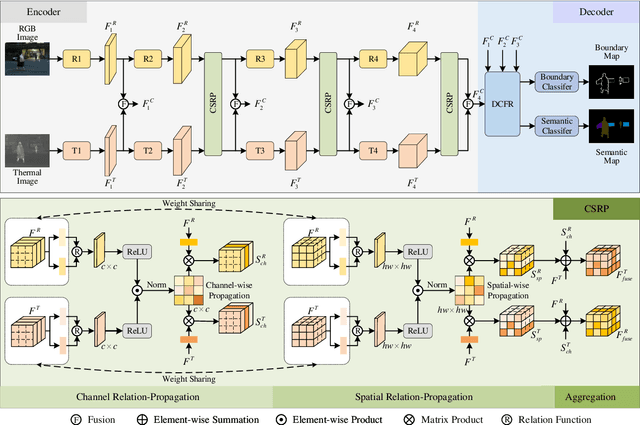Guoqing Zhu
Learning A Robust RGB-Thermal Detector for Extreme Modality Imbalance
May 28, 2025Abstract:RGB-Thermal (RGB-T) object detection utilizes thermal infrared (TIR) images to complement RGB data, improving robustness in challenging conditions. Traditional RGB-T detectors assume balanced training data, where both modalities contribute equally. However, in real-world scenarios, modality degradation-due to environmental factors or technical issues-can lead to extreme modality imbalance, causing out-of-distribution (OOD) issues during testing and disrupting model convergence during training. This paper addresses these challenges by proposing a novel base-and-auxiliary detector architecture. We introduce a modality interaction module to adaptively weigh modalities based on their quality and handle imbalanced samples effectively. Additionally, we leverage modality pseudo-degradation to simulate real-world imbalances in training data. The base detector, trained on high-quality pairs, provides a consistency constraint for the auxiliary detector, which receives degraded samples. This framework enhances model robustness, ensuring reliable performance even under severe modality degradation. Experimental results demonstrate the effectiveness of our method in handling extreme modality imbalances~(decreasing the Missing Rate by 55%) and improving performance across various baseline detectors.
Data Generation Scheme for Thermal Modality with Edge-Guided Adversarial Conditional Diffusion Model
Aug 07, 2024Abstract:In challenging low light and adverse weather conditions,thermal vision algorithms,especially object detection,have exhibited remarkable potential,contrasting with the frequent struggles encountered by visible vision algorithms. Nevertheless,the efficacy of thermal vision algorithms driven by deep learning models remains constrained by the paucity of available training data samples. To this end,this paper introduces a novel approach termed the edge guided conditional diffusion model. This framework aims to produce meticulously aligned pseudo thermal images at the pixel level,leveraging edge information extracted from visible images. By utilizing edges as contextual cues from the visible domain,the diffusion model achieves meticulous control over the delineation of objects within the generated images. To alleviate the impacts of those visible-specific edge information that should not appear in the thermal domain,a two-stage modality adversarial training strategy is proposed to filter them out from the generated images by differentiating the visible and thermal modality. Extensive experiments on LLVIP demonstrate ECDM s superiority over existing state-of-the-art approaches in terms of image generation quality.
Channel and Spatial Relation-Propagation Network for RGB-Thermal Semantic Segmentation
Aug 24, 2023



Abstract:RGB-Thermal (RGB-T) semantic segmentation has shown great potential in handling low-light conditions where RGB-based segmentation is hindered by poor RGB imaging quality. The key to RGB-T semantic segmentation is to effectively leverage the complementarity nature of RGB and thermal images. Most existing algorithms fuse RGB and thermal information in feature space via concatenation, element-wise summation, or attention operations in either unidirectional enhancement or bidirectional aggregation manners. However, they usually overlook the modality gap between RGB and thermal images during feature fusion, resulting in modality-specific information from one modality contaminating the other. In this paper, we propose a Channel and Spatial Relation-Propagation Network (CSRPNet) for RGB-T semantic segmentation, which propagates only modality-shared information across different modalities and alleviates the modality-specific information contamination issue. Our CSRPNet first performs relation-propagation in channel and spatial dimensions to capture the modality-shared features from the RGB and thermal features. CSRPNet then aggregates the modality-shared features captured from one modality with the input feature from the other modality to enhance the input feature without the contamination issue. While being fused together, the enhanced RGB and thermal features will be also fed into the subsequent RGB or thermal feature extraction layers for interactive feature fusion, respectively. We also introduce a dual-path cascaded feature refinement module that aggregates multi-layer features to produce two refined features for semantic and boundary prediction. Extensive experimental results demonstrate that CSRPNet performs favorably against state-of-the-art algorithms.
 Add to Chrome
Add to Chrome Add to Firefox
Add to Firefox Add to Edge
Add to Edge